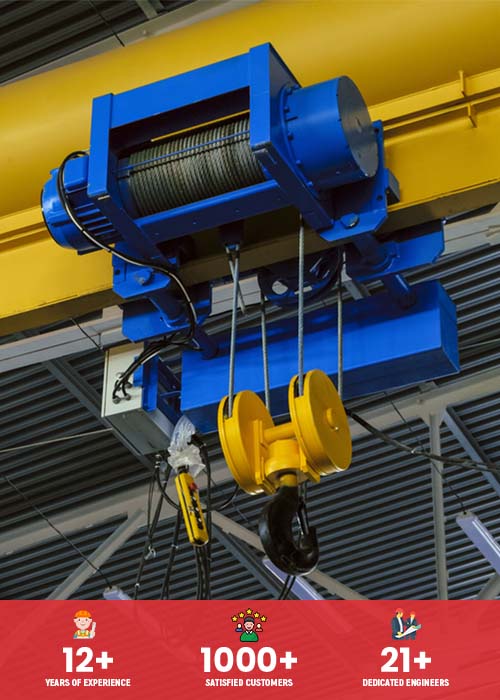Top 5 Market Trends Influencing the Future of Crane and Hoist Manufacturing
India’s infrastructure development is on an upswing. From ambitious projects like Smart Cities Mission and dedicated freight corridors to the increasing focus on renewable energy, the demand for efficient and advanced lifting solutions is surging. This presents a golden opportunity for hoist and crane manufacturers in India. But what trends are shaping the future of this industry? Let’s explore the top 5 trends that will influence how cranes and hoists are designed, manufactured, and used in India. The crane and hoist industry is on the cusp of a transformation. Driven by innovation and global shifts, manufacturers are rethinking how these workhorses will tackle the challenges of tomorrow. Here are five key trends that will influence the future of crane and hoist manufacturing:
1. Boom in Infrastructure Projects Driving Demand for Advanced Lifting Solutions
The Indian government’s push for infrastructure development is fueling the demand for heavy-duty cranes and hoists. The Smart Cities Mission, with a budget of Rs 100 lakh crore, aims to develop 100 smart cities across India. These projects require cranes for tasks like building construction, bridge erection, and laying pipelines. Similarly, dedicated freight corridors spanning thousands of kilometers necessitate a robust fleet of cranes for track laying and maintenance.
The renewable energy sector is another key driver. India has set an ambitious target of achieving 450 GW of installed renewable energy capacity by 2030. This translates to a massive increase in wind farms and solar parks, which require cranes for installing turbines and solar panels. According to a report by Allied Market Research, the global mobile crane market is expected to reach a value of USD 22.47 billion by 2027, and India is expected to be a major contributor to this growth.

2. Focus on Safety and Efficiency: Technological Advancements
With the rise of large-scale projects and the increasing emphasis on worker safety, hoist and crane manufacturers in India are incorporating advanced technologies. Telematics, which involves integrating data from sensors with cloud-based platforms, is playing a crucial role. Sensors on cranes can monitor factors like load weight, wind speed, and equipment health. This data is transmitted wirelessly, allowing for real-time remote monitoring and preventive maintenance. This not only reduces downtime but also helps prevent accidents by identifying potential issues before they escalate.
There’s also a growing adoption of electric and hybrid cranes. A report by Mordor Intelligence suggests that the Asia Pacific electric hoist market will witness a Compound Annual Growth Rate (CAGR) of 5.2% during 2020-2025. These cranes offer significant advantages over traditional diesel-powered models. They produce lower emissions, making them ideal for indoor applications and environmentally sensitive projects. Additionally, electric cranes have lower operating costs due to reduced fuel consumption and maintenance needs.
Advanced safety features are becoming an essential part of modern cranes. Anti-collision systems use sensors and cameras to prevent cranes from colliding with each other or with obstacles. Load limiting devices ensure that cranes don’t exceed their safe lifting capacity, preventing accidents and equipment damage.
3. Localization and Make in India Initiative
The Indian government’s Make in India initiative is encouraging domestic production of cranes and hoists. This initiative aims to reduce dependence on imported equipment and boost local manufacturing capabilities. The government has introduced various policies, including tax breaks and subsidies, to incentivize domestic production. This creates a significant opportunity for Indian hoist and crane manufacturers to cater to the growing demand within the country.
Localization also fosters skill development in the crane and hoist sector. By manufacturing cranes in India, there’s a need for skilled professionals who can design, fabricate, operate, and maintain these complex machines. This not only creates job opportunities but also ensures a skilled workforce that can meet the evolving needs of the industry.
4. Emerging Rental Market and Rise of Flexible Ownership Models
The traditional model of owning cranes and hoists might not be feasible for all construction companies, especially smaller ones. This has led to the emergence of a robust crane and hoist rental market in India. Companies can now rent cranes and hoists for specific projects, eliminating the need for large upfront investments and the burden of storage and maintenance. This flexibility allows construction companies to optimize their budgets and access the latest equipment for specific lifting needs.
The rise of online rental platforms is further streamlining the rental process. These platforms connect construction companies with crane and hoist rental providers, making it easier to find the right equipment at competitive rates. With the increasing popularity of online platforms, the crane and hoist rental market in India is expected to grow significantly in the coming years.
5. Data-Driven Design and Customization for Enhanced Performance
The future of crane and hoist manufacturing lies in data-driven design and customization. Manufacturers are increasingly using big data to analyze operational data from existing cranes. This data helps them understand how cranes are being used, identify areas for improvement, and optimize crane design for better performance and efficiency.
Customization is another key trend. Gone are the days of one-size-fits-all cranes. Today, manufacturers are offering cranes and hoists tailored to specific site and lifting requirements. This can include factors like




